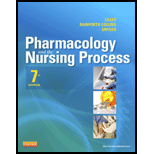
To review:
The functions of the autonomic nervous system and the impact of the parasympathetic division.
Introduction:
The central nervous system (CNS) and peripheral nervous system (PNS) are considered as the two important branches of the nervous system. The CNS consists of the spinal cord and brain, whereas the PNS contains autonomic (ANS) and somatic nervous system (SNS). The ANS is further divided into the sympathetic or adrenergic and parasympathetic or cholinergic. The main functional unit of ANS is visceral reflex and it involves the body homeostasis.
Explanation of Solution
Functions of the autonomic nervous system:
The autonomic nervous system consists of complex neurons that innervate and influence all the
Impact of the parasympathetic nervous system:
The parasympathetic nervous system is a part of the autonomic nervous system which has the opposite function to the sympathetic nervous system. In PNS, the nerve impulse transmission to effector cells is carried out by acetylcholine neurotransmitters. The functions of PNS are mediated by binding of cholinergic receptors to the acetylcholine receptors. Nicotinic and muscarinic receptors are determined based on the location and action of the cholinergic receptors.
Nicotinic receptor is located at the ganglia of the ANS and SNS and it is stimulated by the nicotine. It is a receptor of ligand-controlled cation channels for potassium and sodium ions.
Muscarinic receptors is a cholinergic receptor coupled with G-protein and they control the ion channels. They are located in all effector cells innervated by postganglionic cholinergic fibers of smooth muscles, cardiac muscles, and glands. This receptor is stimulated by muscarinic- an alkaloid muscarine from mushrooms.
Thus, autonomic nervous involves the body homeostasis and it impacts the parasympathetic nervous system by binding of cholinergic receptors to the acetylcholine neurotransmitters.
Want to see more full solutions like this?
- 69. 70. 71. 72. 73. 74.arrow_forward63. 64. 65. Rhythm: P wave: QRS Complex: Rate: PRI: Interpretation: Rhythm: P wave: QRS Complex: 66. 67. 68. Rhythm: P wave: QRS Complex: Rhythm: P wave: QRS Complex: Rate: PRI: Interpretation: Rate: PRI: Interpretation: Rate: PRI: Interpretation:arrow_forward59. 57. 60. 62. 55. سلسلہ ་་་་arrow_forward
- • Define the first stage of labour. • Describe the physiology of the first stage of labour. • Enumerate any four (4) potential complications during puerperium and highlight key measures to manage these complications.arrow_forward• Define obstetric emergencies and state and briefly explain any two (2) maternal, foetal, and obstetric complications that require immediate intervention. • Explain how mental health services can be effectively integrated into maternal and child health, viz-a-viz early childhood development. • Enumerate any four (4) foetal malpresentations in pregnancy and briefly explain their implication in labour while also highlighting their causes and possible complications.arrow_forward• Briefly highlight the physiological changes in pregnancy in relation to cardiovascular and endocrine systems, as well as the uterus and the skin. • Discuss the current antenatal care approach for pregnant women and provide the highlight of activities conducted during woman’s antenatal visit, clearly describing the steps needed for successful antenatal care. • Enumerate any three (3) abnormalities related to placental development and their implications to pregnancy or childbirth.arrow_forward
- 58 64. Rhythm: Clues: Rhythm: Clues: 62 Rhythm QRS Complex Rates PRI Interpretation Rhythm: P wave QRS Complex Rate PRI Interpretation Rhythm: Clues: Rhythm P wave: QRS Complex Rate PRI Interpretation: Rhythm: P wave: QRS Complex: Rate: Interpretation: 67 Rhythm: P wave: QRS Complex: Rate: PRI Interpretation: Rhythm: P wave: QRS Complex: Rate: PRI Interpretation: 68 Rhythm P waves QRS Complex Rate PRI Interpretation Rhythm P wave QRS Complex Rhythm: P wave QRS Complex: Rate PRI Interpretations Rate PRI Interpretationarrow_forward51. 52. 53. Rhythm: Clues: Rhythm: Clues: Rhythm: Clues:arrow_forwardRegularity- Rate- P waves- PRI- QRS- Interpretation- atrial dysrthmia,junctional dysrthymia,and ventricular rhythm,heart blocks,normal sinus,PVCarrow_forward
- normal sinus,atrial dysrthmia,junctional dysrthymia,and ventricular rhythm,heart blocks,PVCarrow_forwardnormal sinus,atrial dysrthmia,junctional dysrthymia,and ventricular rhythm,heart blocksarrow_forwardA 40-year-old male farmer was rushed to an ER with complaints of fever, abdominal pain/tenderness, nausea and vomiting. Clinical examination and investigations revealed diagnosis of typhoid perforation and he was booked for exploratory laparotomy. Explain in detail the pre - operative care of this patient.arrow_forward
 Phlebotomy EssentialsNursingISBN:9781451194524Author:Ruth McCall, Cathee M. Tankersley MT(ASCP)Publisher:JONES+BARTLETT PUBLISHERS, INC.
Phlebotomy EssentialsNursingISBN:9781451194524Author:Ruth McCall, Cathee M. Tankersley MT(ASCP)Publisher:JONES+BARTLETT PUBLISHERS, INC. Gould's Pathophysiology for the Health Profession...NursingISBN:9780323414425Author:Robert J Hubert BSPublisher:Saunders
Gould's Pathophysiology for the Health Profession...NursingISBN:9780323414425Author:Robert J Hubert BSPublisher:Saunders Fundamentals Of NursingNursingISBN:9781496362179Author:Taylor, Carol (carol R.), LYNN, Pamela (pamela Barbara), Bartlett, Jennifer L.Publisher:Wolters Kluwer,
Fundamentals Of NursingNursingISBN:9781496362179Author:Taylor, Carol (carol R.), LYNN, Pamela (pamela Barbara), Bartlett, Jennifer L.Publisher:Wolters Kluwer, Fundamentals of Nursing, 9eNursingISBN:9780323327404Author:Patricia A. Potter RN MSN PhD FAAN, Anne Griffin Perry RN EdD FAAN, Patricia Stockert RN BSN MS PhD, Amy Hall RN BSN MS PhD CNEPublisher:Elsevier Science
Fundamentals of Nursing, 9eNursingISBN:9780323327404Author:Patricia A. Potter RN MSN PhD FAAN, Anne Griffin Perry RN EdD FAAN, Patricia Stockert RN BSN MS PhD, Amy Hall RN BSN MS PhD CNEPublisher:Elsevier Science Study Guide for Gould's Pathophysiology for the H...NursingISBN:9780323414142Author:Hubert BS, Robert J; VanMeter PhD, Karin C.Publisher:Saunders
Study Guide for Gould's Pathophysiology for the H...NursingISBN:9780323414142Author:Hubert BS, Robert J; VanMeter PhD, Karin C.Publisher:Saunders Issues and Ethics in the Helping Professions (Min...NursingISBN:9781337406291Author:Gerald Corey, Marianne Schneider Corey, Cindy CoreyPublisher:Cengage Learning
Issues and Ethics in the Helping Professions (Min...NursingISBN:9781337406291Author:Gerald Corey, Marianne Schneider Corey, Cindy CoreyPublisher:Cengage Learning





